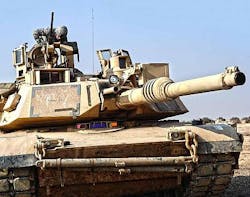Army finalizes $395 million contract to General Dynamics to upgrade M1A2 tank vetronics
STERLING HEIGHTS, Mich., 27 Sept. 2012. Armored combat vehicle designers at General Dynamics Land Systems in Sterling Heights, Mich., won a $395 million eight-year contract from the U.S. Army TACOM Contracting Command for research, development and testing in preparation for the Abrams main battle tank Engineering Change Proposal 1 (ECP1) production, General Dynamics officials announced today.
The Army had announced plans last week to award the tank upgrade contract to General Dynamics. Work will involve upgrades to the M1A2 SEP v2 tank's power, communications, embedded computing, electronic warfare, and targeting vetronics. Army officials had estimated the contract at $383 million; the actual amount is $395 million, General Dynamics officials say.
The Abrams ECP1 program focuses on integrating a group of system tank improvements into one upgrade program for the M1A2 SEP v2 baseline tank to prepare the Abrams combat vehicle to accept future Army requirements without compromising current vehicle performance. The Army plans to start building new tanks with ECP1 upgrades in 2017.
Since its fielding in 1980, enhancements to the Abrams main battle tank have consumed much of the available space, weight and power capacity on the vehicle, General Dynamics officials point out.
ECP1 will re-engineer internal systems to reduce size, weight, and power requirements, creating capacity for additional upgrades in the future. The effort will include miniaturization of electronics; evolving to a line replaceable module (LRM)-based electronics architecture; and increasing electrical capacity by improving power generation, distribution and management.
In addition, when implemented, ECP1 upgrades will improve Abrams' survivability by enhancing armor and adding the capability to employ current and advanced counter-IED equipment, company officials say.
The contract calls for General Dynamics engineers to install several electronics upgrades to the Abrams tank. First, engineers will install the Joint Tactical Radio System (JTRS) handheld manpack and small form fit radios to replace the tank's single-channel ground and airborne radio system (SINCGARS) and Enhanced Position Location Reporting System (EPLRS). The tank's new JTRS software-defined radio will have two-channel communications to support legacy SINCGARS and future radio waveforms.
Next, General Dynamics will install a power generation distribution system with new 1,000-amp alternator, slip ring, hull-processing distribution unit, remote switching modules, and battery monitoring system. These technologies will increase the tank's power to accommodate future electronic technologies. The modified slip rink will be able to pass video and additional power to the turret, Army officials say.
Then the company will install new line-replaceable unit (LRU) and line-replaceable modules (LRM) hardware on the Abrams tank for obsolescence management, SWaP growth, and increased energy efficiency. The LRU/LRM design will capitalize on industry standards for single-board computer interfaces, and accommodate Gigabit Ethernet data communications.
Also on tap for the upgraded M1A2 SEP v2 tank is the latest versions of the counter-remote-control improvised explosive device (IED) electronic warfare (CREW) system.
General Dynamics also will install a new Ammunition Data Link (ADL) to program the tank's M8294E4 advanced kinetic energy and advanced multi-purpose ammunition. The ADL, which passes important platform information to the round, consists of a modified breech block circuit card, cables, software, and ammunition selection switches.
Next for the upgrade tank is a new auxiliary power unit (APU) to operate on-board systems while giving the tank a reduced probability of detection during silent operations. The APU will save fuel, and reduce the number of batteries on each tank from 12 to six.
General Dynamics will do the work in Sterling Heights, Mich., and should be finished by 2020. Army officials plan to operate the Abrams tank through 2050.
For more information contact General Dynamics Land Systems online at www.gdls.com., or the Army Contracting Command at www.army.mil/ACC.
Follow Military & Aerospace Electronics and Avionics Intelligence news updates on Twitter

